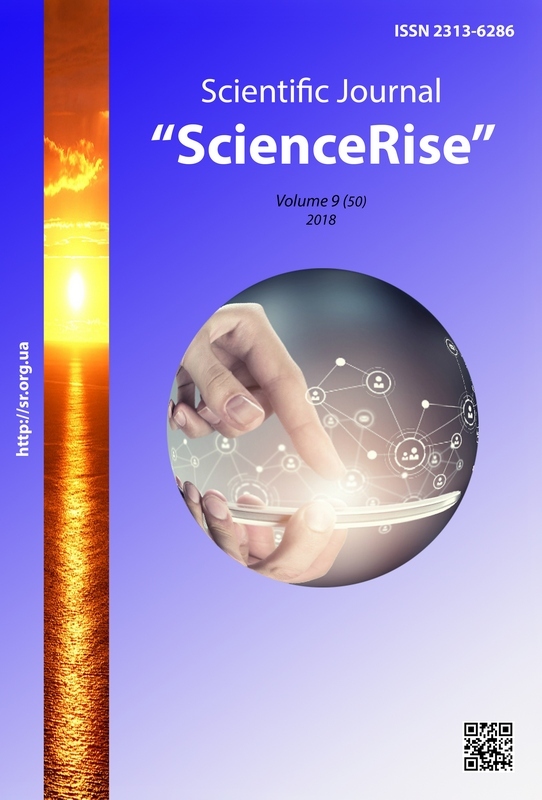Практичні рекомендації по розрахунку карнизних вузлів гнутоклеєних рам з клеєної деревини з врахуванням складного напруженого стану
DOI:
https://doi.org/10.15587/2313-8416.2018.153370Ключові слова:
клеєна деревина, напруженодеформований стан, карнизний вузол, гнутоклеєна рама, складний напружений станАнотація
На підставі експериментальних даних уточнені коефіцієнти At, Ac та Bc,c.90 умови міцності для карнизних вузлів гнутоклеєних рам. Запропоновані практичні рекомендації по розрахунку карнизних вузлів гнутоклеєних рам з врахуванням складного напруженого стану клеєної деревини та встановлені небезпечні точки по довжині карнизного вузла для різних співвідношень кривини карнизного вузла r/h співідношень hmax/L. Розроблені блок-схеми для розрахунку гнутоклеєних рам з співвідношеннями кривини карнизного вузла r/h<4 та r/h≥4
Посилання
Klimenko, V. Z., Naichuk, A. Ya., Fursov, V. V., Mykhailovskiy, D. V. (2010). Proektirovanie sovremennyh konstrukciy iz kleenoy drevesiny na principah novoy koncepcii [Designing modern laminated wood constructions on the principles of a new concept]. Kyiv: Stal, 24.
Serov, E. N. (1982). O rezultatakh obsledovanyia nekotorykh vydov konstruktsyi iz kleenoi drevesyny [On the results of the examination of some types of LTC]. Oblegchennyh konstrukcii iz drevesiny, fanery i plastmass. Leningrad: LISI, 5–9.
Turkovskii, S. B., Varfolomeev, Yu. A. (1984). Rezultaty naturnykh obsledovanyi dereviannykh konstruktsyi [The results of field surveys of wooden structures]. Promyshlennoe stroitel'stvo, 6, 19–20.
Naichuk, A. Ya. (2005). O nekotorykh prychynakh povrezhdenyi dereviannykh konstruktsyi v protsesse ekspluatatsiy [On some causes of damage to wooden structures during operation]. Unikal'nye spec. tekhnologii. Derevyannye kleenye konstrukcii: perspektivy razvitiya rynka Rossii s uchetom mirovogo opyta, 1 (2), 71–73.
Orlovich, R. B., Naichuk, A. Ya. (1981). Nekotorye prychyny avaryi dereviannykh konstruktsyi v selskokhoziaistvennykh zdanyiakh [Some causes of accidents of wooden structures in agricultural buildings]. Povyshenie effektivnosti stroitel'stva zhivotnovodcheskih i proizvodstvennyh zdaniy i sooruzheniy. Tezisy dokl. pervoy respublikanskoy nauchno-prakticheskoy konferencii. Brest, 30–31.
Mykhailovskii, D. V., Matiushchenko, D. M. (2011). Chyselni doslidzhennia napruzhenoho stanu v karnyznykh vuzlakh hnutokleienykh ram [Numerical investigations of the stressed state in the cornice nodes of the bended glued frames]. Resursoekonomni materialy, konstruktsiyi, budivli ta sporudy, 21, 244–250.
Timber Engineering Notebook No. 5: Timber frame structures – platform frame construction (part 3) (2013). The Structural Engineer, 91 (7), 43–50.
Orlovich, R. B., Filimonov, N. S., Zhuk, V. V. (1980). Naybolee sushchestvennye pryznaky rassloenyia i rastreskyvanyia elementov nesushchykh kleenykh dereviannykh konstruktsyi [The most significant signs of stratification and cracking of elements of the bearing glued wooden structures]. Problemy sel'skohozyaystvennogo stroitel'stva. Minsk: Uradzhay, 78–83.
Lomakin, A. D. (1971). Yssledovanye sostoianyia dereviannykh konstruktsyi v selskokhoziaistvennykh zdanyiakh s povyshennoi ekspluatatsyonnoi vlazhnostiu [Study of the state of wooden structures in agricultural buildings with high operating humidity]. Moscow, 18.
Natakhin, V. G. (1981). Osnovnye prychyny defektov nesushchykh kleenykh dereviannykh konstruktsyi selskykh proyzvodstvennykh zdanyi [The main causes of defects bearing glued wooden structures of rural industrial buildings]. Nesushchie derevyannye konstrukcii. Moscow, 116–124.
Ivanov, Yu. M. (1992). K klassifikacii razrusheniy v elementah derevyannyh konstrukciy [To the classification of damage in the elements of wooden structures]. Izvestiya VUZov. Ser.: Stroitel'stvo, 1, 11–13
Kabanov, V. A. (2003). Nadezhnost elementov dereviannykh konstruktsyi [The reliability of the elements of wooden structures]. Kursk, 47.
Yoshihara, H. (2004). Mode II R-curve of wood measured by 4-ENF test. Engineering Fracture Mechanics, 71 (13-14), 2065–2077. doi: https://doi.org/10.1016/j.engfracmech.2003.09.001
Serov, E. N. (1988). Racional'noe ispol'zovanie anizotropii prochnosti materialov v kleenyh derevyannyh konstrukciyah massovogo izgotovleniya [Rational use of the anisotropy of the strength of materials in glued wooden structures of mass production]. Leningrad, 521.
Vasic, S., Smith, I. (2002). Bridging crack model for fracture of spruce. Engineering Fracture Mechanics, 69 (6), 745–760. doi: https://doi.org/10.1016/s0013-7944(01)00091-1
Mikhaylovskiy, D., Matyuschenko, D. (2016). Numerical researches of DGRP-type experimental frames using the finite elements method. Odes’kyi Politechnichnyi Universytet. Pratsi, 2, 14–23. doi: https://doi.org/10.15276/opu.2.49.2016.04
Mykhailovskiy, D. V., Matiushchenko, D. M. (2010). Shchodo vyznachennia radialnykh napruzhen v kryvoliniynykh karnyznykh vuzlakh ram z kleienoi derevyny [Concerning determination of radial stresses in curvilinear cornice nodes of frames made of glued wood]. Mistobuduvannia ta terytorialne planuvannia, 38, 241–245.
DSTU-N B.V.2.6-184:2012. Konstruktsiyi z tsilnoi i kleienoi derevyny. Nastanova z proektuvannia (2016). Kyiv: Minrehionbud Ukrainy, 127–130
Tabunov, S. Yu. (1984). Raschet i vybor optimal'nyh parametrov ram s pryamolineynym rigelem i gnutokleenymi stoykami dlya sel'skohozyaystvennyh zdaniy [Calculation and selection of optimum parameters of frames with a straight-line bolt and bended glued pillars for agricultural buildings]. Leningrad.
##submission.downloads##
Опубліковано
Номер
Розділ
Ліцензія
Авторське право (c) 2018 Denis Mykhailovskii, Dmytro Matiushchenko

Ця робота ліцензується відповідно до Creative Commons Attribution 4.0 International License.
Наше видання використовує положення про авторські права Creative Commons CC BY для журналів відкритого доступу.
Автори, які публікуються у цьому журналі, погоджуються з наступними умовами:
1. Автори залишають за собою право на авторство своєї роботи та передають журналу право першої публікації цієї роботи на умовах ліцензії Creative Commons CC BY, котра дозволяє іншим особам вільно розповсюджувати опубліковану роботу з обов'язковим посиланням на авторів оригінальної роботи та першу публікацію роботи у цьому журналі.
2. Автори мають право укладати самостійні додаткові угоди щодо неексклюзивного розповсюдження роботи у тому вигляді, в якому вона була опублікована цим журналом (наприклад, розміщувати роботу в електронному сховищі установи або публікувати у складі монографії), за умови збереження посилання на першу публікацію роботи у цьому журналі.

